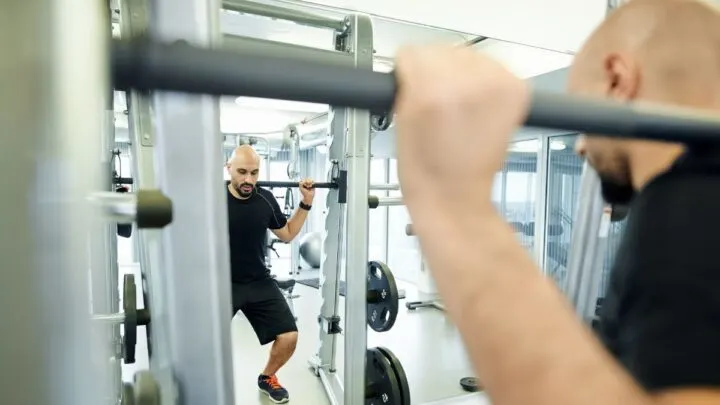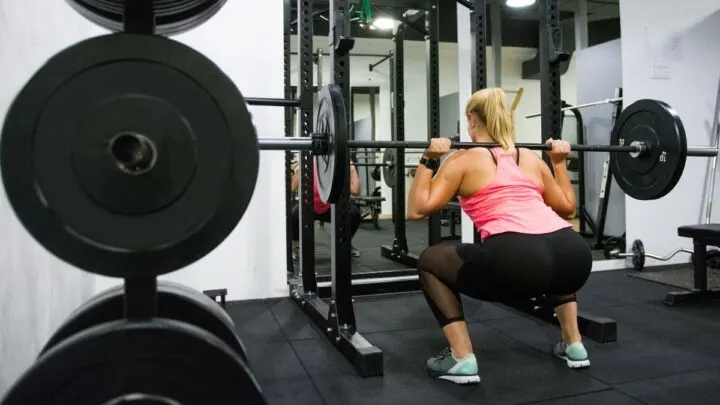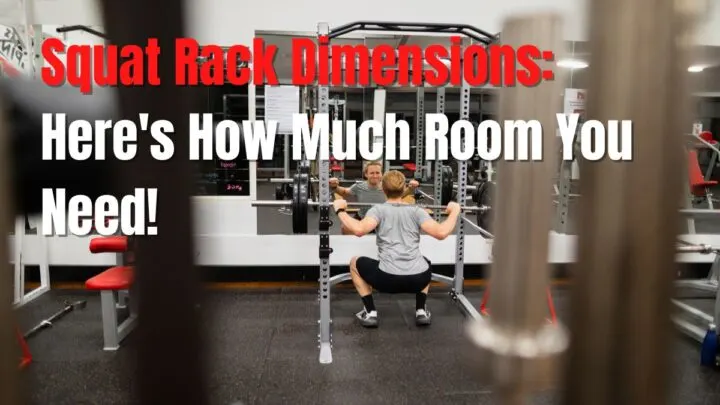A power rack is one of the most essential equipment in a gym. It is a set of metal bars that fully surround an athlete when they are lifting barbells.
A squat rack is another variation of the power rack which takes less space than the full power rack.
For a home gym, the largest a squat rack should be is 85 inches wide by 95 inches tall. Compared to a squat stand which consists of merely two vertical bars or posts on a stand, a squat rack is caged with four or six posts and has a wider base which adds to the safety of the athlete. It also has two horizontal bars on the top for added support.
Alternatively, these top bars can also be used for doing pull ups.
Even though the squat rack takes up less room than the full power rack, it still needs ample space for the athlete to move around comfortably and for easily placing weights onto the rack.

Squat Racks Spacing Requirements
Since squat racks are a budget-friendly option for weight lifting exercises, they can be installed in home gyms.
Also, squat racks have a lower weight limit compared to power racks, thus they are often found in homes and in small gyms.
While squat racks can be as tall and as wide as one wants, the largest a squat rack can be for home gyms is 85 inches wide and 95 inches tall.
The 85 inches width is large enough to accommodate even the lengthier barbells. The taller the rack is, the more weight it can store.
A taller squat rack can also offer pullup options.
However, one also has the option for installing smaller squat racks if there is a space limitation.
Squat racks can be as small as 36×36 inches in width and 72 inches in height on an average.
Medium sized squat racks can range from 60-72 inches in width and up to 90 inches in height.
However, the size of the squat rack depends on you if you are having one custom made.
Even though the squat racks might have a shorter width and lower height, the smaller squat racks still need clearance space to store the typical 6.5-7.2 foot barbell length.
So, squat racks need at least a 75 inch width so it can store a 6.5 inch barbell.
A smaller squat rack might seemingly save space, but it may need more clearance space than a large sized or a mid-sized squat rack.
Squat Rack Clearance Requirements
If you have a smaller area and are going to measure the space to the tee, you should measure the width of the squat rack you can house by keeping at least 2 feet margin on all sides.
This is so the squat racks do not disrupt from using other equipment in the space, or result in injuries because of barbells falling onto the ground from an accidental nudge to the rack.
You also need to keep in account the length of the barbell and how much space it needs to place on the squat rack even if you are not looking for a squat rack that is roomy enough to store barbells.
The clearance is also required for space for any additional accessories added to the squat rack later on.
This includes J-cups, safeties, pull-up bars, and weight storage options.
However, if there is a space limitation, a small squat rack with at least 2 feet clearance from the front and 1 feet clearance from the other three sides can be installed.
The barbell length should be taken in consideration and the clearance space should be available for the barbell on the level where it is placed while exercising if clearance space is not available on the ground.
This will allow you to continue exercising at home within a limited space.
However, the only drawback is that you would not be able to store multiple barbells on the rack at the same time.
If you want to switch weight, you will have to go to the place where you have stored them or change the weight plates on one or two available barbells.
Squat Rack Weight Capacity
Based on the dimensions of a squat rack, the weight of the squat rack can vary and so can the weight holding capacity.
It ranges from as light as 250 pounds to as heavy as 600 pounds based on the type of material used, the dimensions, and the number of additional accessories added onto the rack.
The squat rack dimensions you choose also depends on the amount of weights you want to hold on the rack.
If you want to hold multiple barbells and weights on the squat rack, a heavier rack which is bolted onto the ground for support will be the best option.
A 6-post rack is often more stable in terms of weight carrying as well as can house more weights than a 4-post squat rack can.
This is the reason that typical squat racks which are ready to use come with 4 posts. A 6-post rack requires more space and comes in the category of power racks.
However, you can get a custom-made squat rack for your home gym and increase the number of posts it has to 6 to increase its weight holding capacity and feasibility for the user.

Summing Up the Dimensions of Squat Racks
Squat racks are a great addition to your home gym if you are strength training.
It has functions like holding the barbell while you are exercising and also storing those barbells at the back which are not in use.
Even though squat racks take less space than 6-post power racks, they still need space for the athlete to move around comfortably and keep the barbell without disrupting other equipment.
While small sized squat racks might physically take less space, they still need clearance to hold the barbells.
If the home gym does not have space on the ground, it is recommended to choose a smaller squat rack without weight storage options which can save space.


